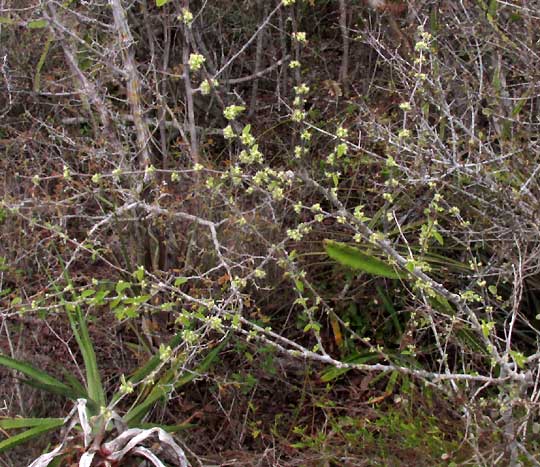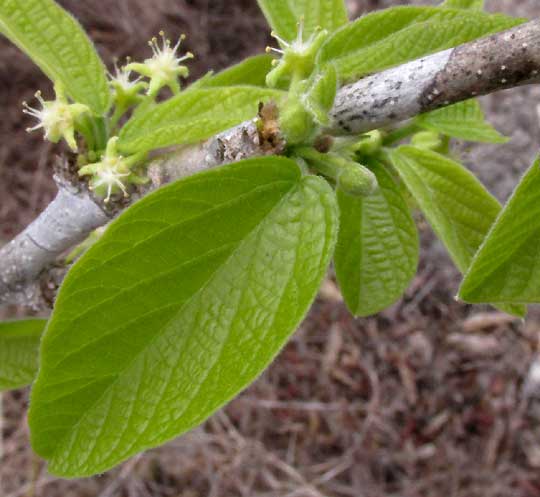Excerpts from Jim Conrad's
Naturalist Newsletter
from the June 14, 2015 Newsletter issued from Río Lagartos, on the Yucatan Peninsula's northern coast (~N21.60°, ~W88.16°), Yucatán state, MÉXICO
OAXACA ADELIA
Not far from the Enriquebeltrania crenatifolia trees -- so also on very thin soil atop limestone bedrock that probably is flooded during the rainy season -- a similarly scrubby, much-entangled-with-other-bushes woody plant also was flowering, as shown below:

Up closer I was surprised to see that the tight clusters of little white flowers, exactly as with the Enriquebeltrania trees, consisted of nothing but greenish sepals spreading below clusters of male stamens, as shown below:

The sepals hairiness was unusual so I got a photo emphasizing that, shown below:

Leaves were emerging after last week's first rain of the rainy season, so, below, you can see that they were pinnately veined, had slightly eared bases, that the bases were symmetrical, and that the blades' margins were without teeth or lobes -- entire:

Only three or four of these shrubs were found and none bore female flowers or fruits. Still, with the similarity of the male flowers to those of the Enriquebeltrania trees, I figured that this was probably a member of the Euphorbia or Poinsettia Family, the Euphorbiaceae, so off I went to the wonderful interactive key to the world's genera of that family at http://keys.lucidcentral.org/key-server/player.jsp?keyId=66.
With that key, just by using features clearly seen in the pictures, and the fact that we're in southeastern Mexico, the possibilities were narrowed to three genera of which only one looked anything like our plants, the genus Adelia.
Two Adelia species are listed for Ría Lagartos Biosphere, and of those two species the one with leaves like ours is ADELIA OAXACANA, sometimes in English literature known as the Oaxaca Adelia, Oaxaca being a southern Mexican state and pronounced like "wa-HA-ka."
To firm up the ID, an Adelia male flower on the Internet was found looking very much like ours, with exceptionally long-hairy sepals. That picture appears at http://malpighiales.myspecies.info/taxonomy/term/133/media.
Adelia oaxacana is described as present in arid regions of central and southern Mexico, so it's much more commonly distributed than the Enriquebeltrania trees around it, but where I found it much less common.